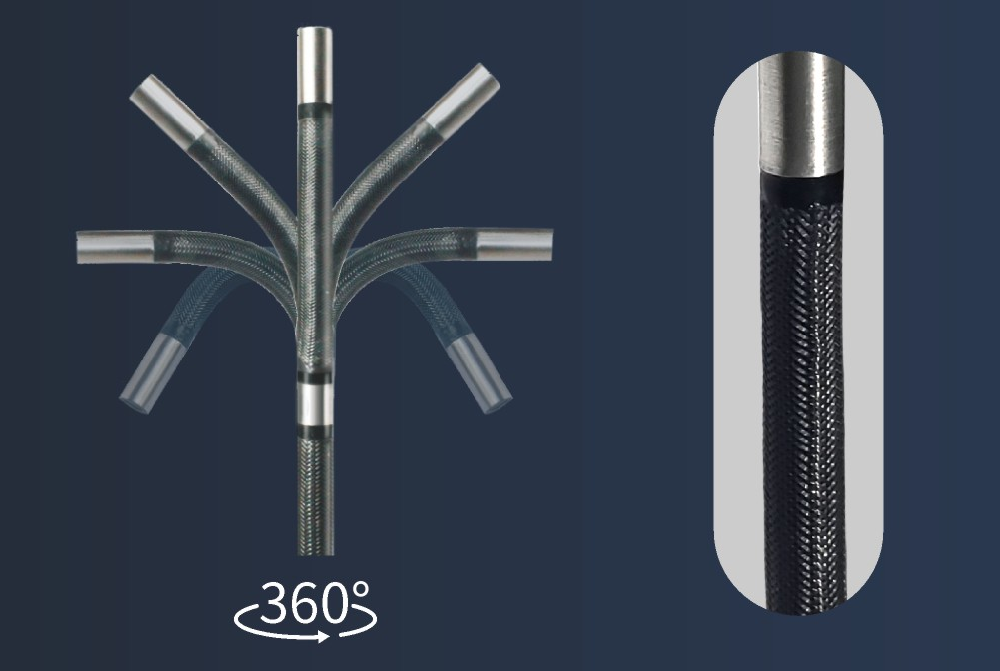360° Articulating Industrial Endoscope: Expanding Horizons with Advanced Inspection Tool
2023-07-27
In the realm of modern industries, accurate and comprehensive inspection and observation are crucial for ensuring smooth operations and maintaining equipment. However, many devices and systems often have confined and hard-to-reach areas, which traditional visual inspection tools cannot adequately address. Fortunately, with the continuous advancements in technology, the 360° articulating industrial endoscope has emerged as a solution, providing us with a panoramic and flexible view to explore and resolve issues in these challenging areas.
1.Basic Principles of Industrial Endoscopes:
An industrial endoscope is a portable observation tool comprising flexible optical fibers and optical devices. It functions by transmitting images from confined areas to a monitor or screen using optical sensors, allowing operators to observe and analyze the inspected regions in real-time.
2.Advantages of the 360° Articulating Technology:
While traditional industrial endoscopes offer a limited field of view, the 360° articulating industrial endoscope provides a fully encompassing perspective and maneuverability through its flexible probe rotation design. This technology enables operators to rotate and navigate the endoscope, delving deep into every corner and edge of the equipment to spot potential issues and defects.
3.Applications in Automotive Maintenance and Inspection:
The 360° articulating industrial endoscope finds extensive usage in automotive maintenance and inspection. It can be deployed to examine hard-to-reach regions such as the internal components of engines, transmission systems, chassis, and automotive bodies. For instance, engineers can utilize this tool to inspect engine pistons and valves, detect wear and oil leakage in suspension systems, and identify cracks and corrosion in chassis components, thereby ensuring vehicle safety and performance by timely detection and resolution of potential problems.

4.Applications in Industrial Maintenance and Repair:
Beyond the automotive industry, the 360° articulating industrial endoscope plays a vital role in industrial maintenance and repair. It can be employed to inspect pipelines, internal machinery, tunnels, and fan systems, among other narrow and inaccessible areas. This facilitates engineers in swiftly identifying blockages, corrosion, or damages within pipes, enabling effective maintenance strategies and reducing downtime and costs.
5.Applications in the Construction Sector:
In the construction domain, the 360° articulating industrial endoscope finds wide application for inspecting walls, electrical conduits, drainage systems, and structural internals. It allows engineers to uncover hidden issues such as water leaks, faulty electrical connections, or structural defects. Early detection and resolution of these problems contribute to ensuring the safety and reliability of buildings.
6.Applications in Sewage Treatment and Pipe Inspection:
Sewage treatment and pipe inspection represent another crucial field that benefits from the 360° articulating industrial endoscope. It can enter the interior of pipes to conduct comprehensive inspections. This technology aids in detecting water accumulation, corrosion, cracks, and blockages within the pipes, enabling operators to devise effective maintenance plans.
The 360° articulating industrial endoscope is a crucial technological innovation in the modern industrial landscape. By providing a panoramic view and observational capability, it empowers professionals in the automotive industry, industrial maintenance and repair, construction sector, and sewage treatment to accurately detect and analyze issues in challenging areas. This, in turn, enhances work efficiency, mitigates the risk of failures, and contributes to the smooth operation and maintenance of equipment. As technology continues to advance, it is anticipated that the 360° articulating industrial endoscope will further evolve and offer enhanced functionalities and applications, driving progress and innovation in the industrial realm



